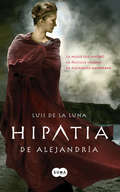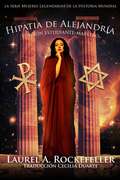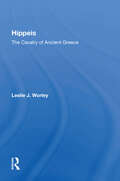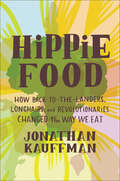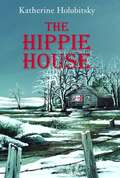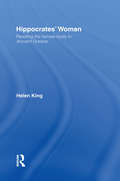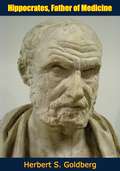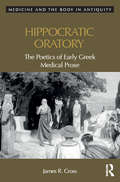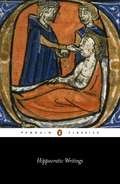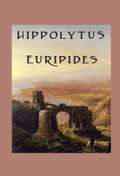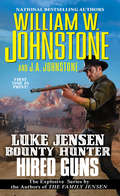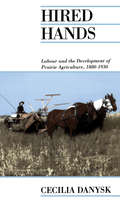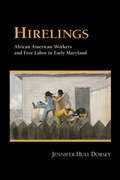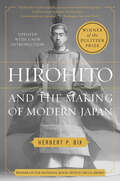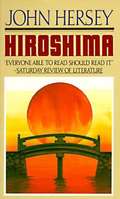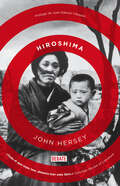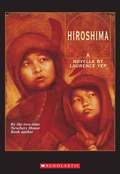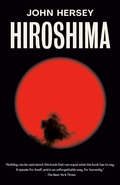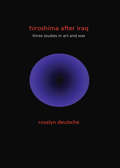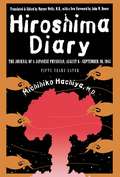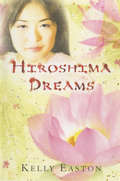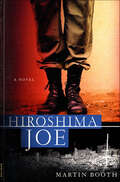- Table View
- List View
Hipatia de Alejandría
by De la Luna, LuisEste libro recrea la vida de Hipatia de Alejandría, una figura capital de la antigüedad y protagonista del filme Ágora, de Alejandro Amenábar. Estuvo versada en filosofía, matemáticas y astronomía, pero su clase magistral para la historia fueron su sed de vida y de conocimiento, así como el valor y la entereza para defender sus ideales de convivencia y tolerancia. Hipatia fue un espíritu libre, una voz incómoda a causa de la férrea voluntad de llevar una vida plena como mujer sin pedir perdón por ello, aunque debiera pagar por ello el más alto precio: la vida. Antes de que la marea de la intolerancia arrase todo, tenemos ocasión de vislumbrar un fastuoso mundo crepuscular, y por sus páginas cruzan personajes de raza, como el joven príncipe Atila, y se visitan ciudades de ensueño en el esplendor de su apogeo: Constantinopla y Alejandría. "Había una mujer en Alejandría que se llamaba Hipatia, que logró tales alcances en literatura y ciencia, que sobrepasó en mucho a todos los filósofos de su propio tiempo". SÓCRATES ESCOLÁSTICO
Hipatia de Alejandría: Edición Estudiante - Maestro (Mujeres Legendarias de la Historia Mundial #9)
by Laurel A. RockefellerDefender la Luz Mientras el mundo occidental caía en la oscuridad, ella se atrevió a defender la luz. Hipatia de Alejandría, nacida en el año 355, tras el reinado de Constantino, vivió en un Imperio Romano que se derrumbaba, un mundo en el que la obediencia a las autoridades religiosas triunfaba sobre la ciencia, en el que la razón y la lógica amenazaban el nuevo orden mundial. Era un mundo al borde de la Edad Media, un mundo que decidía la cuestión de la ciencia versus la religión, la libertad versus la ortodoxia, la tolerancia versus el odio. Durante más de 40 años, Hipatia se interpuso entre la Edad Media y la luz de la filosofía, las artes y las ciencias clásicas. Aunque ninguno de sus libros sobrevivió a las agresivas quemas de libros de los fanáticos religiosos, su legado sigue siendo el de una de las más grandes científicas de todos los tiempos. La edición para estudiantes y profesores incluye preguntas de estudio desafiantes al término de cada capítulo, además de una detallada línea de tiempo y una extensa lista de lecturas sugeridas.
Hippeis: The Cavalry Of Ancient Greece
by Leslie J WorleyThe achievements of the Greek cavalry on the battlefield were monumental, and yet until now the heavy infantry - the hoplite - has received by far the most attention from military historians. This book traces the history of the Greek cavalry, offering a reassessment of the place of mounted troops in the warfare of Ancient Greece. Its historical sweep is broad, with coverage which extends from 1400 BC, through the Archaic period to the Classical period.
Hippie Food: How Back-to-the-Landers, Longhairs, and Revolutionaries Changed the Way We Eat
by Jonathan Kauffman“An outstanding food and cultural history . . . details how the concept of health food [evolved and] inspired the food co-ops and whole food stores [of] today.” —Publishers Weekly, starred reviewFood writer Jonathan Kauffman journeys back more than half a century—to the 1960s and 1970s—to tell the story of how a coterie of unusual men and women embraced an alternative lifestyle that would ultimately change how modern Americans eat. Impeccably researched, Hippie Food chronicles how the longhairs, revolutionaries, and back-to-the-landers rejected the square establishment of President Richard Nixon’s America and turned to a more idealistic and wholesome communal way of life and food.From the mystical rock-and-roll cult known as the Source Family and its legendary vegetarian restaurant in Hollywood to the Diggers’ brown bread in the Summer of Love to the rise of the co-op and the origins of the organic food craze, Kauffman reveals how today’s whole-foods staples—including sprouts, tofu, yogurt, brown rice, and whole-grain bread—were introduced and eventually became part of our diets. From coast to coast, through Oregon, Texas, Tennessee, Minnesota, Michigan, Massachusetts, and Vermont, Kauffman tracks hippie food’s journey from niche oddity to cuisine that hit every corner of this country.“An astute, highly informative food expose that educates without bias.” —Kirkus Reviews“Alongside playful prose the great joy of Hippie Food is its rich cast of characters.” —Wall Street Journal“Fascinating.” —NPR’s The Salt“Briskly entertaining . . . I thought I knew this story, but Kauffman has added a lot to it, in the way of both fresh information and narrative verve.” —Michael Pollan for the New York Times
Hippie House
by Katherine HolubitskySummer, 1970. When a local girl is found brutally murdered, the freedom and innocence of "the summer of love" are forgotten and for fourteen-year-old Emma, things will never be the same.
Hippocrates' Woman: Reading the Female Body in Ancient Greece
by Helen KingHippocrates' Woman demonstrates the role of Hippocratic ideas about the female body in the subsequent history of western gynaecology. It examines these ideas not only in the social and cultural context in which they were first produced, but also the ways in which writers up to the Victorian period have appealed to the material in support of their own theories.Among the conflicting tange of images of women given in the Hippocratic corpus existed one tradition of the female body which says it is radically unlike the male body, behaving in different ways and requiring a different set of therapies. This book sets this model within the context of Greek mythology, especially the myth of Pandora and her difference from men, to explore the image of the body as something to be read.Hippocrates' Woman presents an arresting study of the origins of gynaecology, an exploration of how the interior workings of the female body were understood and the influence of Hippocrates' theories on the gynaecology of subsequent ages.
Hippocrates, Father of Medicine: Father Of Medicine
by Herbert S. GoldbergFirst published in 1963, this book by University of Missouri Microbiology Professor Herbert S. Goldberg provides the reader with a picture of the life and times of Hippocrates, the “Father of Medicine.” Hippocrates was born on the island of Cos in 460 B.C., and his works remained for centuries the foundation of medical and biographical knowledge. In addition, it was Hippocrates daring approach to the problems of sickness and disease that drove the opening wedge into the wall of fear that surrounded human ills. Hippocrates scrupulous attention to professional ethics is honored even to this day by the medical oath that bears his name—The Hippocratic Oath.Goldberg accurately describes the professions and trades during Hippocrates time, as well as the early education of youth in ancient Greece. Medicines were not based on science, but on driving evil spirits from the body. Hippocrates scientific approach to the study and treatment of disease has deservedly earned for him the title of “Father of Medicine.”
Hippocratic Oratory: The Poetics of Early Greek Medical Prose (Medicine and the Body in Antiquity)
by James R. CrossOn Ancient Medicine, On the Art, On Breaths, On the Nature of Human Beings and On the Sacred Disease are among the most well-known and sophisticated works of the Hippocratic Collection. The authors of these treatises were seeking to find means to express their arguments that built on authoritative models of their predecessors. By examining the range of expressive resources used in their expository prose, James Cross demonstrates how oral tradition and written techniques, such as sound patterning, sign-posting and antithetical formulae, were deployed to help the writers develop a case. The book demonstrates that there were various layers of meaning and manners of communicating ideas which can be found in Hippocratic expository prose, and offers fresh insights into the oral debating culture and experiments in persuasion which characterise the ancient Greek world of the late fifth-century BCE.
Hippocratic Writings
by HippocratesThis work is a sampling of the Hippocratic Corpus, a collection of ancient Greek medical works. At the beginning, and interspersed throughout, there are discussions on the philosophy of being a physician. There is a large section about how to treat limb fractures, and the section called The Nature of Man describes the physiological theories of the time. The book ends with a discussion of embryology and a brief anatomical description of the heart.
Hippolytus
by EuripidesNo play of Euripides is more admired than Hippolytus. The tale of a married woman stirred to passion for a younger man was traditional, but Euripides modified this story and blended it with one of divine vengeance to create a masterpiece of tension, pathos, and dramatic power. In this play, Phaedra fights nobly but unsuccessfully against her desire for her stepson Hippolytus, while the young man risks his life to keep her passion secret. Both of them, constrained by the overwhelming force of divine power and human ignorance, choose to die in order to maintain their virtue and their good names.
Hira Singh
by Talbot MundyOne hundred Indian troops of the British Army have arrived at Kabul, Afghanistan, after a four months' march from Constantinople. The men were captured in Flanders by the Germans and were sent to Turkey in the hope that, being Mohammedans, they might join the Turks. But they remained loyal to Great Britain and finally escaped, heading for Afghanistan. They now intend to join their regimental depot in India, so it is reported. New York Times, July, 1915
Hired Guns (Luke Jensen Bounty Hunter #8)
by William W. Johnstone J.A. JohnstoneJohnstone Country. Where Frontier Legends Are Born. A legend among bounty hunters, Luke Jensen has tracked some of the deadliest outlaws in the West. But sometimes, the competition can be even deadlier . . . GHOST TOWN MASSACRE It’s the kind of job Luke Jensen hates. A millionaire mine owner is willing to pay $5,000 to the man who captures the half-breed outlaw Tom Eagle. Normally, Luke would turn down an offer like this—it smacks too much of being a hired gun. But when the millionaire tells him that Eagle is responsible for killing his son, Luke agrees to take on the job. Which means he’ll have to take the road to hell itself—aka Hard Rock, Montana . . . Hard Rock is supposed to be a ghost town. But when Luke arrives, the ghosts are alive and well—and gunning for his hide. They’re a gang of actual hired guns—the kind of soulless killers Luke despises—and they’re trying to collect the bounty, too. Luke barely makes it out of town alive when he runs in to the only man who can save him. The man he’s been hired to hunt. The notorious Tom Eagle . . . Live Free. Read Hard.
Hired Hands:
by Cecilia DanyskFarm workers were central to the development of Canada's prairie West. From 1878, when the first shipment of prairie grain went to international markets, to 1929, when the Great Depression signalled the end of the wheat boom, the role of hired hands changed dramatically. Prior to World War One, hired hands viewed themselves and were treated in the rural community as equals to their farmer employers. Many were farmers in training, informal apprentices who worked for wages so they could accumulate the capital and experience needed to secure their own free 160-acre parcels of land. In later years, as free lands were taken, hired hands increasingly faced the hkehhood of remaining waged labourers on the farms of others. They became agricultural proletarians. In this first full-length study of labour in Canadian prairie agriculture during the period of settlement and expansion, Cecilia Danysk examines the changing work and the growing rural community of the West through the eyes of the workers themselves. World War One was a catalyst in bringing into focus the conflicting nature of labour-capital relations and the divergent aims of workers and their employers. Yet, attempts at union organization were unsuccessful because most hired hands worked alone and because governments assisted farmers by stifling such attempts. The workers' greatest form of workplace control was to walk off one job and find another. Previously published by McClelland & Stewart
Hirelings: African American Workers and Free Labor in Early Maryland
by Jennifer Hull DorseyIn Hirelings, Jennifer Hull Dorsey re-creates the social and economic milieu of Maryland’s Eastern Shore at a time when black slavery and black freedom existed side by side. She follows a generation of manumitted African Americans and their freeborn children and grandchildren through the process of inventing new identities, associations, and communities in the early nineteenth century. Free Africans and their descendants had lived in Maryland since the seventeenth century, but before the American Revolution they were always few in number and lacking in economic resources or political leverage. By contrast, manumitted and freeborn African Americans in the early republic refashioned the Eastern Shore’s economy and society, earning their livings as wage laborers while establishing thriving African American communities. As free workers in a slave society, these African Americans contested the legitimacy of the slave system even while they remained dependent laborers. They limited white planters’ authority over their time and labor by reuniting their families in autonomous households, settling into free black neighborhoods, negotiating labor contracts that suited the needs of their households, and worshipping in the African Methodist Episcopal Church. Some moved to the cities, but many others migrated between employers as a strategy for meeting their needs and thwarting employers’ control. They demonstrated that independent and free African American communities could thrive on their own terms. In all of these actions the free black workers of the Eastern Shore played a pivotal role in ongoing debates about the merits of a free labor system.
Hiring Fair (The Stalker Trilogy #2)
by Jessica StirlingThis is the second book in the trilogy recounting the story of the Stalker's. Drew studies law in Edinburgh determined never to return to the poverty of his childhood. Mirrin, after her bitter experiences with Houston Lamont, owner of Blacklaw Colliery, soon has to decide whether to try her luck on the London music-hall stage or search for the man who could bring her happiness. Life was changing too for the Stalkers who remained in Blacklaw. After a bloody pit riot Houston Lamont joins his avaricious wife in an unholy alliance to drain every drop of profit out of the miners. Look for the other books in the Stalker trilogy, a sweeping historical family saga about life in Scotland in the 1870s in the Bookshare collection. They are: #1 The Spoiled Earth and #2 The Dark Pasture. These novels are authentic in detail and lavishly describe the rural and city landscapes and lives of the Scottish people in the lower, middle and wealthy classes as they seek sustenance, security, advancement, and fulfillment. You will find another trilogy by Jessica Stirling, The Isle of Mull Trilogy which are: #2 The Wind From the Hills and #3
Hirohito And The Making Of Modern Japan
by Herbert P BixWinner of the Pulitzer PrizeIn this groundbreaking biography of the Japanese emperor Hirohito, Herbert P. Bix offers the first complete, unvarnished look at the enigmatic leader whose sixty-three-year reign ushered Japan into the modern world. Never before has the full life of this controversial figure been revealed with such clarity and vividness. Bix shows what it was like to be trained from birth for a lone position at the apex of the nation's political hierarchy and as a revered symbol of divine status. Influenced by an unusual combination of the Japanese imperial tradition and a modern scientific worldview, the young emperor gradually evolves into his preeminent role, aligning himself with the growing ultranationalist movement, perpetuating a cult of religious emperor worship, resisting attempts to curb his power, and all the while burnishing his image as a reluctant, passive monarch. Here we see Hirohito as he truly was: a man of strong will and real authority.Supported by a vast array of previously untapped primary documents, Hirohito and the Making of Modern Japan is perhaps most illuminating in lifting the veil on the mythology surrounding the emperor's impact on the world stage. Focusing closely on Hirohito's interactions with his advisers and successive Japanese governments, Bix sheds new light on the causes of the China War in 1937 and the start of the Asia-Pacific War in 1941. And while conventional wisdom has had it that the nation's increasing foreign aggression was driven and maintained not by the emperor but by an elite group of Japanese militarists, the reality, as witnessed here, is quite different. Bix documents in detail the strong, decisive role Hirohito played in wartime operations, from the takeover of Manchuria in 1931 through the attack on Pearl Harbor and ultimately the fateful decision in 1945 to accede to an unconditional surrender. In fact, the emperor stubbornly prolonged the war effort and then used the horrifying bombings of Hiroshima and Nagasaki, together with the Soviet entrance into the war, as his exit strategy from a no-win situation. From the moment of capitulation, we see how American and Japanese leaders moved to justify the retention of Hirohito as emperor by whitewashing his wartime role and reshaping the historical consciousness of the Japanese people. The key to this strategy was Hirohito's alliance with General MacArthur, who helped him maintain his stature and shed his militaristic image, while MacArthur used the emperor as a figurehead to assist him in converting Japan into a peaceful nation. Their partnership ensured that the emperor's image would loom large over the postwar years and later decades, as Japan began to make its way in the modern age and struggled -- as it still does -- to come to terms with its past.Until the very end of a career that embodied the conflicting aims of Japan's development as a nation, Hirohito remained preoccupied with politics and with his place in history. Hirohito and the Making of Modern Japan provides the definitive account of his rich life and legacy. Meticulously researched and utterly engaging, this book is proof that the history of twentieth-century Japan cannot be understood apart from the life of its most remarkable and enduring leader.
Hiroshima
by John HerseyMemories and tales from the survivors of the atomic bomb dropped on Hiroshima on August 6, 1945. 37 years later, Hersey went back to Japan. The final chapter is what he found there.
Hiroshima
by John HerseyLa crónica sobre seis supervivientes de Hiroshima que se convirtió en un gran clásico del periodismo. «Toda persona que sepa leer, debería leer este libro.»Saturday Review of Literature El verano de 1945, William Shawn, director ejecutivo de The New Yorker, habló con el reportero John Hersey sobre la idea de publicar un relato que ilustrara la dimensión humana de los efectos de la bomba atómica en Hiroshima, pues le causaba estupor comprobar que, pese a la gran cantidad de información sobre la bomba que recibían, se estaba ignorando lo que realmente había ocurrido en Hiroshima. El reportero aceptó el encargo. Hershey viajó a Hiroshima para investigar y entrevistar a varios supervivientes de la explosión de la bomba atómica, lanzada el 6 de agosto de 1945, y decidió que el retrato lo conformarían seis testimonios: una oficinista, Toshiko Sasaki; un médico, el Dr. Masakazu Fuji;una viuda a cargo de sus tres hijos pequeños, Hatsuyo Nakamura; un misionero alemán, el padre Wilhem Kleinsorge; un joven cirujano, el Dr. Terufumi Sasaki y un pastor metodista, el reverendo Kiyoshi Tanimoto. La publicación de Hiroshima trajo consigo una enorme conmoción. El reportaje se publicó en una edición monotemática de The New Yorker el 31 de agosto de 1946. La revista se agotó inmediatamente y de todo el mundo llegó una avalancha de peticiones de reimpresión. Su difusión corrió como la pólvora y en pocos meses la editorial Alfred A. Knopf lo publicó como libro, permitiendo que al año siguiente ya se hubiera traducido y publicado prácticamente en todo el mundo. En la actualidad Hiroshima lleva vendidos más de un millón de ejemplares y es un referente del periodismo de investigación y un clásico de la literatura de guerra. Es el único artículo, entre los millares de textos escritos sobre la bomba atómica, que describe cómo era la vidapara las personas que habían sobrevivido a un ataque nuclear. Y está considerado como «el más famoso artículo de revista jamás publicado». Reseñas:«No se puede decir nada sobre este libro que esté al nivel de lo que este libro dice. Habla por sí mismo y, de un modo memorable, por la humanidad entera.»The New York Times «Hay poco que se le pueda comparar en el periodismo universal.»Arcadi Espada, El País
Hiroshima
by Laurence YepOn the morning of August 6, 1945, an American bomber, the Enola Gay, roars down the runway of the Pacific island, Tinian. Its target is Hiroshima, Japan. Its cargo is an atom bomb.
Hiroshima
by Ran ZwigenbergIn 1962, a Hiroshima peace delegation and an Auschwitz survivor's organization exchanged relics and testimonies, including the bones and ashes of Auschwitz victims. This symbolic encounter, in which the dead were literally conscripted in the service of the politics of the living, serves as a cornerstone of this volume, capturing how memory was utilized to rebuild and redefine a shattered world. This is a powerful study of the contentious history of remembrance and the commemoration of the atomic bomb in Hiroshima in the context of the global development of Holocaust and World War II memory. Emphasizing the importance of nuclear issues in the 1950s and 1960s, Zwigenberg traces the rise of global commemoration culture through the reconstruction of Hiroshima as a 'City of Bright Peace', memorials and museums, global tourism, developments in psychiatry, and the emergence of the figure of the survivor-witness and its consequences for global memory practices.
Hiroshima (Penguin Modern Classics Ser.)
by John HerseyPulitzer Prize-winning journalist and bestselling author John Hersey's seminal work of narrative nonfiction which has defined the way we think about nuclear warfare. &“One of the great classics of the war" (The New Republic) that tells what happened in Hiroshima during World War II through the memories of the survivors of the first atomic bomb ever dropped on a city. "The perspective [Hiroshima] offers from the bomb&’s actual victims is the mandatory counterpart to any Oppenheimer viewing." —GQ Magazine &“Nothing can be said about this book that can equal what the book has to say. It speaks for itself, and in an unforgettable way, for humanity.&” —The New York Times Hiroshima is the story of six human beings who lived through the greatest single manmade disaster in history. John Hersey tells what these six -- a clerk, a widowed seamstress, a physician, a Methodist minister, a young surgeon, and a German Catholic priest -- were doing at 8:15 a.m. on August 6, 1945, when Hiroshima was destroyed by the first atomic bomb ever dropped on a city. Then he follows the course of their lives hour by hour, day by day.The New Yorker of August 31, 1946, devoted all its space to this story. The immediate repercussions were vast: newspapers here and abroad reprinted it; during evening half-hours it was read over the network of the American Broadcasting Company; leading editorials were devoted to it in uncounted newspapers.Almost four decades after the original publication of this celebrated book John Hersey went back to Hiroshima in search of the people whose stories he had told. His account of what he discovered about them -- the variety of ways in which they responded to the past and went on with their lives -- is now the eloquent and moving final chapter of Hiroshima.
Hiroshima After Iraq: Three Studies in Art and War (The Wellek Library Lectures)
by Rosalyn DeutscheMany on the left lament an apathy or amnesia toward recent acts of war. Particularly during the George W. Bush administration's invasion of Iraq, opposition to war seemed to lack the heat and potency of the 1960s and 1970s, giving the impression that passionate dissent was all but dead. Through an analysis of three politically engaged works of art, Rosalyn Deutsche argues against this melancholic attitude, confirming the power of contemporary art to criticize subjectivity as well as war. Deutsche selects three videos centered on the deployment of the atomic bomb: Krzysztof Wodiczko's Hiroshima Projection (1999), made after the first Gulf War; Silvia Kolbowski's After Hiroshima mon amour (2005-2008); and Leslie Thornton's Let Me Count the Ways (2004-2008), which followed the U.S. invasion of Iraq. Each of these works confronts the ethical task of addressing historical disaster, and each explores the intersection of past and present wars. These artworks profoundly contribute to the discourse of war resistance, illuminating the complex dynamics of viewing and interpretation. Deutsche employs feminist and psychoanalytic approaches in her study, questioning both the role of totalizing images in the production of warlike subjects and the fantasies that perpetuate, especially among the left, traditional notions of political dissent. She ultimately reveals the passive collusion between leftist critique and dominant discourse in which personal dimensions of war are denied.
Hiroshima Diary
by Michihiko HachiyaThe late Dr. Michihiko Hachiya was director of the Hiroshima Communications Hospital when the world's first atomic bomb was dropped on the city. Though his responsibilities in the appalling chaos of a devastated city were awesome, he found time to record the story daily, with compassion and tenderness. His compelling diary was originally published by the UNC Press in 1955, with the help of Dr. Warner Wells of the University of North Carolina at Chapel Hill, who was a surgical consultant to the Atomic Bomb Casualty Commission and who became a friend of Dr. Hachiya. In a new foreword, John Dower reflects on the enduring importance of the diary fifty years after the bombing.
Hiroshima Dreams
by Kelly EastonLin can't explain the knowledge she has of the future, of what people will say or what will happen. It's a gift she shares with Obaasan, her grandmother, who has recently come from Japan to live with Lin's family. But seeing the future is more than knowing whether or not a boy will call. What is Lin to make of the visions she has of a day long ago, when the atomic bomb was dropped on Hiroshima? Acclaimed author Kelly Easton's poignant coming-of-age novel about a girl with psychic abilities is rich in imagery and memorable characters.
Hiroshima Joe: A Novel
by Martin BoothOne of the most powerful novels about the experience of war, first published in 1985Captured by Hirohito's soldiers at the fall of Hong Kong and transferred to a Japanese slave camp outside Hiroshima, Captain Joe Sandingham was present when the bomb was dropped. Now a shell of a man, he lives in a cheap Hong Kong hotel, scrounging for food and the occasional bar girl. The locals call him "Hiroshima Joe" with a mixture of pity and contempt. But Joe—haunted by the sounds and voices of his past, debilitated by illness, and shattered by his wartime ordeal—is a man whose compassion and will to survive define a clear-eyed and unexpected heroism.
